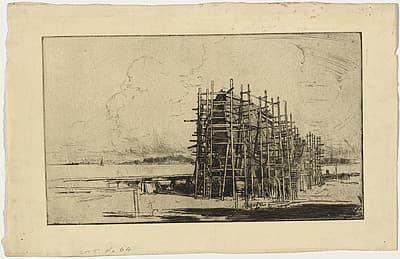
Sydney
LONG
Australia
1871
–
London
1955
England, Europe 1910-21; Australia 1921- 22; England 1922-25; Australia 1925-52; England from 1952
18.6 (h) x 31.6 (w) cm
undesignated impression , published state? , edition unkown? , no manufacturer's mark
No inscriptions.
Reference: Mendelssohn (1979), 52; Paul (1928), 64 National Gallery of Australia, Canberra NGA 1986.1278 Gift of T.S. Paul in memory of Dorothy Ellsmore Paul 1986 Reproduced with the kind permission of the Ophthalmic Research Institute of Australia
- Collection of the artist and cataloguer of Sydney Long's etchings, Dorothy Ellsmore Paul. Gift of her nephew T S Paul to the NGA, 1986.
The wooden ship shows a ship under construction on a slipway, surrounded by wooden scaffolding. This was the Burnside, built by the shipbuilders, Kidman & Mayoh, which remained unfinished on the slipway until September 1923. Her hull was then stripped of useable timber, and what remained was burnt where it stood in the stocks. The end of the First World War in November 1918 meant that there was no longer any need for wooden ships. It was a sad end for what was one of the biggest wooden vessels ever built in Australia.
The shipyards were located at Kissing Point, Putney (near Ryde) on the Parramatta River from 1918 to 1922. Kidman & Mayoh built ships using timber brought down from the north coast of New South Wales. ‘Bush carpenters’ from the north coast came to work in the shipyard, assisting the skilled shipwrights whose labour was in short supply. Some local men also got jobs in the yards as blacksmiths and labourers.
Long’s interest in depicting scaffolding may have been influenced by the work of the British printmaker Frank Brangwyn, such as his etching Shipbuilding yard 1904. Brangwyn made a number of etchings depicting boat building and scaffolding in which the structures of the scaffolding are central to the design of his images.
A copy of The wooden ship was first exhibited in 1923 at the ‘Third annual exhibition of the Australian Painter–Etchers’ Society’, Sydney, 3–21 July (2, as ‘The old wooden ship’). Another copy is held by the Art Gallery of New South Wales.
The wooden ship shows a ship under construction on a slipway, surrounded by wooden scaffolding. This was the Burnside, built by the shipbuilders, Kidman & Mayoh, which remained unfinished on the slipway until September 1923. Her hull was then stripped of useable timber, and what remained was burnt where it stood in the stocks. The end of the First World War in November 1918 meant that there was no longer any need for wooden ships. It was a sad end for what was one of the biggest wooden vessels ever built in Australia.
The shipyards were located at Kissing Point, Putney (near Ryde) on the Parramatta River from 1918 to 1922. Kidman & Mayoh built ships using timber brought down from the north coast of New South Wales. ‘Bush carpenters’ from the north coast came to work in the shipyard, assisting the skilled shipwrights whose labour was in short supply. Some local men also got jobs in the yards as blacksmiths and labourers.
Long’s interest in depicting scaffolding may have been influenced by the work of the British printmaker Frank Brangwyn, such as his etching Shipbuilding yard 1904. Brangwyn made a number of etchings depicting boat building and scaffolding in which the structures of the scaffolding are central to the design of his images.
A copy of The wooden ship was first exhibited in 1923 at the ‘Third annual exhibition of the Australian Painter–Etchers’ Society’, Sydney, 3–21 July (2, as ‘The old wooden ship’). Another copy is held by the Art Gallery of New South Wales.
The wooden ship shows a ship under construction on a slipway, surrounded by wooden scaffolding. This was the Burnside, built by the shipbuilders, Kidman & Mayoh, which remained unfinished on the slipway until September 1923. Her hull was then stripped of useable timber, and what remained was burnt where it stood in the stocks. The end of the First World War in November 1918 meant that there was no longer any need for wooden ships. It was a sad end for what was one of the biggest wooden vessels ever built in Australia.
The shipyards were located at Kissing Point, Putney (near Ryde) on the Parramatta River from 1918 to 1922. Kidman & Mayoh built ships using timber brought down from the north coast of New South Wales. ‘Bush carpenters’ from the north coast came to work in the shipyard, assisting the skilled shipwrights whose labour was in short supply. Some local men also got jobs in the yards as blacksmiths and labourers.
Long’s interest in depicting scaffolding may have been influenced by the work of the British printmaker Frank Brangwyn, such as his etching Shipbuilding yard 1904. Brangwyn made a number of etchings depicting boat building and scaffolding in which the structures of the scaffolding are central to the design of his images.
A copy of The wooden ship was first exhibited in 1923 at the ‘Third annual exhibition of the Australian Painter–Etchers’ Society’, Sydney, 3–21 July (2, as ‘The old wooden ship’). Another copy is held by the Art Gallery of New South Wales.
